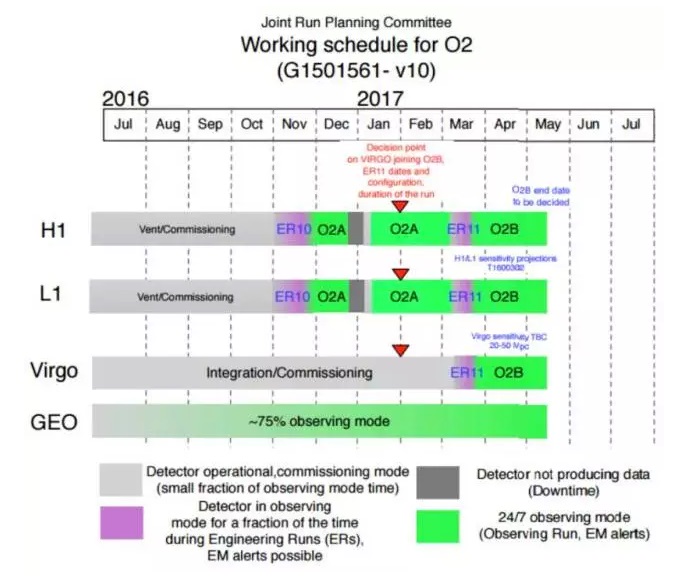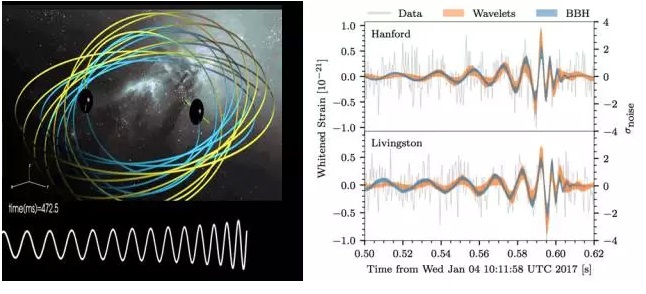博文
aLIGO第三次宣布直接观测到引力波
 精选
精选
|||

图片来自LIGO官网
北京时间2017年5月31日深夜, LIGO和Virgo科学合作组织举行了一次内部媒体发布会, 确认了第三次引力波事件。LIGO发言人麻省理工学院教授大卫•舒梅克首先宣布aLIGO发现了来自两个黑洞并合的新引力波事件GW170104, 以及本次新发现引力波事件的基本特征。为此, 《中国科学:物理学 力学 天文学》特邀LIGO科学合作组清华团队成员李瑾副教授和范锡龙副教授进行了点评, 李瑾副教授还对LIGO的新闻发布原稿进行了翻译。关于GW170104, 请见官方主页: http://www.ligo.org/detections/GW170104.php
以下为点评正文:
自aLIGO (advanced LIGO)于2015年首次直接探测到双黑洞并合的引力波事件GW150914之后, 紧接着于同年的12月又一次探测到新的双黑洞引力波事件GW151226。这两次探测共同验证了广义相对论预言引力波存在的正确性, 并证实了宇宙中的确存在能在宇宙学年龄内并合的双黑洞系统。此次探测到的引力波事件GW170104是继前两次探测之后, aLIGO又经过改进后探测到的不同质量的双黑洞并合事件, 相关的结果发表在近期的Physical Review Letter 期刊上[1]。此次探测不仅为已观测到的双黑洞“家族“增添了新的成员, 还拓展了人类观测宇宙的范围(此次引力波源相距地球30亿光年)。
与前两次探测相比, 本次探测具有更深远的物理意义。主要表现在以下几方面:
本次观测是从aLIGO经新一轮性能提升后采集的数据(官方称为O2轮数据)中发现了该引力波信号。位于华盛顿州Hanford和路易斯安娜州Livingston的两台探测器在2017年1月4日同时记录到了这一信号。由于此次的数据质量较好, 系统灵敏度更高, 因此在O2轮数据开始运行不久就捕获到了来自如此遥远距离的引力波信号。

图1 aLIGO第二轮数据采集时间表。图片版权: LIGO科学合作团队
第一次观测到双黑洞自旋正方向可以与相互旋转轨道的角动量方向不一致。这一结果可以用来区分双黑洞的起源模型。从此次观测结果来看, 双黑洞很可能形成于致密的恒星簇中。另外,广义相对论预言黑洞自旋会对波形演化产生至关重要的影响。因此, 通过观测引力波波形进一步对黑洞自旋进行限制将有助于我们理解和检验广义相对论的动力学预言。

图2 黑洞自旋与双黑洞轨道角动量示意图。图片版权: LIGO科学合作团队

图3 双黑洞环绕、自旋、轨道进动与引力波辐射。图片版权: LIGO科学合作团队
根据广义相对论预言,引力波不存在色散现象。由于GW170104从较远的双黑洞系统传播到地球, 这将更利于我们测试引力波是否存在色散。结合前两次探测到的引力波, 这次对色散因子的上限给出了更严格的限制。目前的结果与广义相对论预言的零色散非常吻合。
引力波科学合作组织仍在不断拓展其探测网络, 同时继续进行着系统升级[2]。相信在不久的将来人类能探测到更多的引力波信号。这不仅为验证广义相对论提供更多的实例, 还将大大提高人类对宇宙的复合观测能力。
我们期待在aLIGO公布的6个触发信号中发现更多有趣的问题。
参考文献
B. Abbott, et al. (LIGO Scientific Collaboration and Virgo Collaboration), GW170104: Observation of a 50-Solar-Mass Binary Black Hole Coalescence at Redshift 0.2, Phys. Rev. Lett. 118, 221101 (2017) https://doi.org/10.1103/PhysRevLett.118.221101
 李瑾, 重庆大学物理学院副教授(硕士生导师), 中国引力与相对论天体物理学会会员、LIGO科学合作组清华团队成员。2008年-2010年期间在LIGO科学团队Ringdown小组中从事数据分析工作, 2010年获得博士学位。曾获得中国国家自然科学基金资助。目前的主要研究领域有: 引力波探测的数据处理、黑洞引力扰动下的引力似正规模辐射。
李瑾, 重庆大学物理学院副教授(硕士生导师), 中国引力与相对论天体物理学会会员、LIGO科学合作组清华团队成员。2008年-2010年期间在LIGO科学团队Ringdown小组中从事数据分析工作, 2010年获得博士学位。曾获得中国国家自然科学基金资助。目前的主要研究领域有: 引力波探测的数据处理、黑洞引力扰动下的引力似正规模辐射。
 范锡龙, 物理学博士。湖北第二师范学院副教授, LIGO科学合作组清华团队成员。曾获得中国国家自然科学基金资助。主要研究领域: 引力波天文学, 引力波数据处理。
范锡龙, 物理学博士。湖北第二师范学院副教授, LIGO科学合作组清华团队成员。曾获得中国国家自然科学基金资助。主要研究领域: 引力波天文学, 引力波数据处理。
新闻发布会文字版(中英对照):
LIGO Detects Gravitational Waves for Third Time
Results confirm new population of black holes
LIGO第三次直接探测到引力波
这一结果为新的恒星级黑洞的存在提供有力的证据
https://www.ligo.caltech.edu/page/press-release-gw170104
The Laser Interferometer Gravitational-wave Observatory (LIGO) has made a third detection of gravitational waves, ripples in space and time, demonstrating that a new window in astronomy has been firmly opened. As was the case with the first two detections, the waves were generated when two black holes collided to form a larger black hole.
激光干涉引力波天文台第三次成功捕捉到宇宙时空的涟漪-引力波。这项成果将全面开启人类认识宇宙的新窗口。与前两次探测到的引力波信号(GW150914、GW151226)类似, 本次信号来自于双黑洞系统融合为更大质量黑洞过程中释放的引力波。
The newfound black hole, formed by the merger, has a mass about 49 times that of our sun. This fills in a gap between the masses of the two merged black holes detected previously by LIGO, with solar masses of 62 (first detection) and 21 (second detection).
本次观测对应的双黑洞并合组成的新型黑洞质量约为太阳的49倍。这刚好介于LIGO前两次观测到的双黑洞系统的质量, 其中第一次观测对应的双黑洞系统质量为太阳质量为62倍, 第二次为太阳质量的21倍。
"We have further confirmation of the existence of stellar-mass black holes that are larger than 20 solar masses—these are objects we didn't know existed before LIGO detected them," says MIT's David Shoemaker, the newly elected spokesperson for the LIGO Scientific Collaboration (LSC), a body of more than 1,000 international scientists who perform LIGO research together with the European-based Virgo Collaboration. "It is remarkable that humans can put together a story, and test it, for such strange and extreme events that took place billions of years ago and billions of light-years distant from us. The entire LIGO and Virgo scientific collaborations worked to put all these pieces together."
作为LIGO科学合作组新当选的发言人, 麻省理工学院的David Shoemaker教授谈到: “我们已经进一步证实了质量大于20个太阳质量的黑洞的存在, 这是在LIGO观测到相应引力波信号之前我们所不能确定的事情。”LIGO科学合作组是一个拥有一千多名来自世界各国科学家组成的科学合作研究机构, 他们与欧洲的Virgo科学合作组一起进行引力波的联合探测。
The new detection occurred during LIGO's current observing run, which began November 30, 2016, and will continue through the summer. LIGO is an international collaboration with members around the globe. Its observations are carried out by twin detectors—one in Hanford, Washington, and the other in Livingston, Louisiana—operated by Caltech and MIT with funding from the National Science Foundation (NSF).
本次观测到的引力波发生在LIGO现阶段观测运行期间, 该运行从2016年11月30日开始一直采集数据到2017年夏季结束。涉及到的两架结构完全相同的探测器位于华盛顿州的Hanford和路易斯安娜州的Livingston, 这两架探测器都由美国自然科学基金(NSF)资助。
LIGO made the first-ever direct observation of gravitational waves in September 2015 during its first observing run since undergoing major upgrades in a program called Advanced LIGO. The second detection was made in December 2015. The third detection, called GW170104 and made on January 4, 2017, is described in a new paper accepted for publication in the journal Physical Review Letters.
经过主体升级后的LIGO称为高新LIGO, 即第二代激光干涉引力波天文台。在Advanced LIGO在开始第一轮数据观测期间, 就第一次成功捕捉到了来自于双黑洞系统融合过程释放的引力波信号,该信号被观测到的时间为2015年9月。紧接着在同年12月, 它第二次检测到了另一双黑洞源释放的引力波信号。第三次于今年1月4日观测到, 命名为GW170104。针对这一结果, LIGO科学合作小组(LSC)共同撰写了一篇论文, 在Physical Review Letters 期刊上发表。
In all three cases, each of the twin detectors of LIGO detected gravitational waves from the tremendously energetic mergers of black hole pairs. These are collisions that produce more power than is radiated as light by all the stars and galaxies in the universe at any given time. The recent detection appears to be the farthest yet, with the black holes located about 3 billion light-years away. (The black holes in the first and second detections are located 1.3 and 1.4 billion light-years away, respectively.)
在这三次探测中, LIGO的每一个探测器都能直接观测从双黑洞融合瞬间释放的引力波。这种引力辐射比宇宙中所有发光星体以及星系在相同时间内的光辐射还要强。最近这次观测到的双黑洞系统所处的位置最远, 它距离地球约30亿光年 (第一次和第二次观测到的黑洞距离地球分别为13和14亿光年)。
The newest observation also provides clues about the directions in which the black holes are spinning. As pairs of black holes spiral around each other, they also spin on their own axes—like a pair of ice skaters spinning individually while also circling around each other. Sometimes black holes spin in the same overall orbital direction as the pair is moving—what astronomers refer to as aligned spins—and sometimes they spin in the opposite direction of the orbital motion. What's more, black holes can also be tilted away from the orbital plane. Essentially, black holes can spin in any direction.
最新的观测结果进一步给出了与双黑洞相互旋转以及自旋方向有关的参数。由于双黑洞系统中的两成员彼此旋转, 同时它们具有自旋, 这如同一对在冰上各自旋转又绕着彼此旋转的滑冰运动员。双黑洞系统中单个黑洞的自旋方向有时与两者相互旋转轨道的旋转方向一致——天文学家称之为平行自旋 , 有时它们的自旋与轨道旋转方向相反——这被称为反平行自旋。此外, 黑洞自旋平面也可以与轨道平面倾斜。一般而言, 黑洞可以在任何方向上自旋。
The new LIGO data cannot determine if the recently observed black holes were tilted but they imply that at least one of the black holes may have been non-aligned compared to the overall orbital motion. More observations with LIGO are needed to say anything definitive about the spins of binary black holes, but these early data offer clues about how these pairs may form.
新的LIGO数据无法确定最近观测到的双黑洞的自旋正方向是否倾斜, 但是它们可以显示出与相互旋转轨道运动方向是否一致或相反, 并且能提供如何形成这一现象的依据。要想更加明确地给出双黑洞自旋的任何信息需要更多的被LIGO观测到的双黑洞引力波事件, 但这些早期的数据可以为寻求双黑洞形成机制提供线索。
"This is the first time that we have evidence that the black holes may not be aligned, giving us just a tiny hint that binary black holes may form in dense stellar clusters," says Bangalore Sathyaprakash of Penn State and Cardiff University, one of the editors of the new paper, which is authored by the entire LSC and Virgo Collaborations.
作为该论文的主要作者之一的宾夕法尼亚州立大学和加迪夫大学的教授Bangalore Sathyaprakash说: “这是我们第一次有证据表明黑洞可能为反向旋转型, 这给我们一个暗示, 双黑洞系统可能在密集的恒星簇中形成。”
There are two primary models to explain how binary pairs of black holes can be formed. The first model proposes that the black holes are born together: they form when each star in a pair of stars explodes, and then, because the original stars were spinning in alignment, the black holes likely remain aligned.
目前, 对于双黑洞的形成有两个主流的模型来解释。在第一个模型中, 处于稠密恒星簇中的黑洞在其生命后期会逐渐聚集到一起。当它们陷入星簇中心后就形成了双黑洞系统。在这种情况下,黑洞的自旋可以在任何方向。
In the other model, the black holes come together later in life within crowded stellar clusters. The black holes pair up after they sink to the center of a star cluster. In this scenario, the black holes can spin in any direction relative to their orbital motion. Because LIGO sees some evidence that the GW170104 blackholes are non-aligned, the data slightly favor this dense stellar cluster theory.
另一种模型预言双黑洞是同时诞生的: 它们形成于双星系统塌缩, 由于最初的双星具有同向自旋,因此产生的双黑洞系统应该也具有同向自旋特征。从LIGO最新一次的探测结果来看, GW170104引力波信号反映出相应的双黑洞系统具有反向自旋。这样, 貌似前一种模型(致密恒星簇模型)与实验更相符。
"We're starting to gather real statistics on binary black hole systems," says Keita Kawabe of Caltech, also an editor of the paper, who is based at the LIGO Hanford Observatory. "That's interesting because some models of black hole binary formation are somewhat favored over the others even now and, in the future, we can further narrow this down."
该论文的另一位作者, 加州理工学院的资深科学家Keita Kawabe谈到“最近我们开始收集关于双黑洞系统的真实统计数据。这很有趣, 因为目前有一些双黑洞系统的形成过程更倾向于另一些理论模型。通过类似的引力波观测, 将来我们可以进一步筛选出合理的理论模型。
The study also once again puts Albert Einstein's theories to the test. For example, the researchers looked for an effect called dispersion, which occurs when light waves in a physical medium such as glass travel at different speeds depending on their wavelength; this is how a prism creates a rainbow. Einstein's general theory of relativity forbids dispersion from happening in gravitational waves as they propagate from their source to Earth. LIGO did not find evidence for this effect.
这项研究能再次通过实验来验证爱因斯坦的一些理论。例如, 研究人员企图寻找一种称为色散的物理效应, 当自然光进入某种物理介质如玻璃后, 不同波长的光波以不同的速度在介质中传播就会产生色散效应。这就是棱镜将白光分成彩虹色的过程。爱因斯坦在广义相对论中预言, 当引力波从波源传播到地球时不会产生类似的色散现象。目前, LIGO的确没有发现引力波有色散效应的证据。
"It looks like Einstein was right—even for this new event, which is about two times farther away than our first detection," says Laura Cadonati of Georgia Tech and the Deputy Spokesperson of the LSC. "We can see no deviation from the predictions of general relativity, and this greater distance helps us to make that statement with more confidence."
Shoemaker说: “对于这个新的黑洞事件, 它的发生地点比我们第一次探测到的波源要远两倍。我们仍然没有找到偏离广义相对论的结果, 更大的距离使我们能够更有信心地认为爱因斯坦的理论看来是正确的。”
“The LIGO instruments have reached impressive sensitivities,” notes Jo van den Brand, the Virgo Collaboration spokesperson, a physicist at the Dutch National Institute for Subatomic Physics (Nikhef) and professor at VU University in Amsterdam. "We expect that by this summer Virgo, the European interferometer, will expand the network of detectors, helping us to better localize the signals.”
荷兰国家亚原子物理研究所(Nikhef)的物理学家, 阿姆斯特丹VU大学的教授, Virgo团队发言人Jo van den Brand表示: “LIGO探测器的灵敏度已经达到惊人的程度。我们预计到今年夏天, Virgo, 欧洲激光干涉仪, 将扩大联合探测网络, 帮助我们更好地对信号进行定位。
The LIGO-Virgo team is continuing to search the latest LIGO data for signs of space-time ripples from the far reaches of the cosmos. They are also working on technical upgrades for LIGO's next run, scheduled to begin in late 2018, during which the detectors' sensitivity will be improved.
LIGO-Virgo科学家们将继续从最新的LIGO数据中搜索宇宙中更遥远地方传来的引力波信号。同时, 他们将于2018年年底开始为LIGO的下一次运行进行技术升级, 届时探测器的灵敏度将得到进一步提高。
"With the third confirmed detection of gravitational waves from the collision of two black holes, LIGO is establishing itself as a powerful observatory for revealing the dark side of the universe," says David Reitze of Caltech, executive director of the LIGO Laboratory. "While LIGO is uniquely suited to observing these types of events, we hope to see other types of astrophysical events soon, such as the violent collision of two neutron stars."
LIGO天文台负责人 David Reitze说: “通过第三次明确探测到由两个黑洞碰撞产生的引力波, LIGO逐步建立起探索宇宙黑暗区域的强大观测能力。虽然LIGO对观测双黑洞碰撞产生引力波这类事件比较敏感, 但我们仍希望将来它能观测到其他类型的天体物理事件, 例如两个中子星的碰撞。”
LIGO is funded by the National Science Foundation (NSF), and operated by MIT and Caltech, which conceived and built the project. Financial support for the Advanced LIGO project was led by NSF with Germany (Max Planck Society), the U.K. (Science and Technology Facilities Council) and Australia (Australian Research Council) making significant commitments and contributions to the project. Morethan 1,000 scientists from around the world participate in the effort through the LIGO Scientific Collaboration, which includes the GEO Collaboration. LIGO partners with the Virgo Collaboration, a consortium including 280 additional scientists throughout Europe supported by the Centre National de la Recherche Scientifique (CNRS), the Istituto Nazionale di Fisica Nucleare (INFN), and Nikhef, as wellas Virgo’s host institution, the European Gravitational Observatory. Additional partners are listed at: http://ligo.org/partners.php.
LIGO由NSF资助, 由加州理工学院和麻省理工学院经营、负责构建和建造该项目。来自世界各地的1000多名科学家通过LIGO科学合作组参与该项目具体工作, 包括GEO。LIGO与Virgo合作, 将另外的280位欧洲科学家联合起来, 得到了包括欧洲国家科学中心(CNRS), 国际自然科学基金委员会(INFN)和Virgo主体机构及欧洲重力观测站的资助。其他合作伙伴参见:http://ligo.org/partners.php。
相关阅读:
《中国科学: 物理学 力学 天文学》出版激光干涉引力波探测专题
《中国科学》杂志社微信公众号
关注请加:scichina1950/中国科学杂志社 或扫描识别二维码:

https://blog.sciencenet.cn/blog-528739-1058680.html
上一篇:深空探测器接近段递归自适应滤波方法研究|《中国科学:信息科学》
下一篇:让这些神秘的植物指纹,带您走进那遥远的时代......